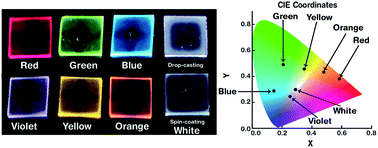White light emission produced by CTMA-DNA nanolayers embedded with a mixture of organic light-emitting molecules
Abstract
Researchers have started to recognize that biomaterial-based devices and sensors can be used in the development of high-performing environmentally-friendly technologies. In this regard, DNA can be utilized as a competent scaffold for hosting functional nanomaterials to develop a designated platform in the field of bionanotechnology. Here, we introduce a novel methodology to construct CTMA-modified DNA nanolayers (CDNA NLs) embedded with single (e.g., red, green, and blue), double (violet, yellow, and orange), and triple (white) iridium-based organic light-emitting materials (OLEMs, including Ir(piq)2(acac) for red, Ir(ppy)2(acac) for green, FIrpic for blue) that can serve as active light-emitting layers. The OLEM-embedded CDNA NLs were fabricated using simple solution processes, and their spectral properties were investigated via Fourier-transform infrared (FTIR), X-ray photoelectron (XPS), UV-Vis, and photoluminescence (PL) spectroscopies. FTIR analysis of OLEM-embedded CDNA NLs suggested that the complexes are stable and chemically inert. XPS revealed the various modes of interaction between OLEMs and CDNA. The evidence of interactions between blue OLEM and CDNA was demonstrated by peak shifts. The wide band gap characteristics (∼4.76 eV) and relatively high optical quality (no absorption in the visible region) of OLEM-embedded CDNA NLs were observed in UV-Vis absorption measurements. We observed PL emission in OLEM-embedded CDNA NLs, which was caused by the energy transfer from CDNA to OLEMs (ligand-centered and metal to ligand charge transfer). Lastly, a white light-emitting OLEM-embedded CDNA thin film was constructed using a combination of appropriate concentrations of red, green, and blue OLEMs. Its characteristic was demonstrated through spectral measurements. In addition, colour coordinates were plotted in the International Commission on Illumination (CIE) colour space, which confirmed the colour identity for the developed colours (including white). Consequently, the OLEM-embedded CDNA NLs can likely be used as a functional material in bio-imaging and bio-photonics.



 Please wait while we load your content...
Please wait while we load your content...